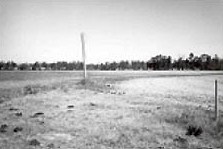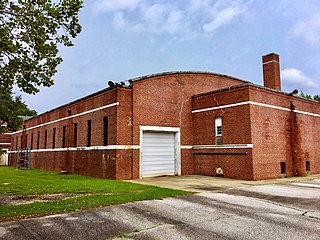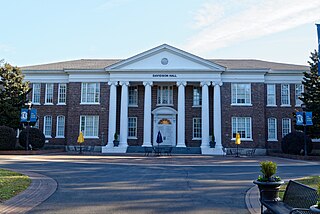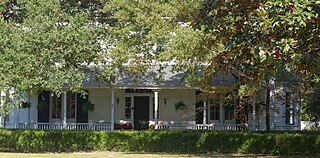
Hartsville is the largest city in Darlington County, South Carolina, United States. It was chartered on December 11, 1891. The population was 7,764 at the 2010 census. Hartsville was chosen as an All-America City in 1996 and again in 2016. Hartsville has also been a National Arbor Day Foundation Tree City since 1986.

Major James Lide Coker was a businessman, merchant, industrialist, Christian philanthropist, and Civil War veteran, and the founder of Sonoco Products Company and Coker College. He was called "The Major" after his service in the Confederate Army.

Coker Experimental Farms, also known as Coker Pedigreed Seed Company, is a National Historic Landmark agricultural site at 1257 South Fourth Street in Hartsville, South Carolina, USA. The property, which is now owned by a museum, was the location where David R. Coker conducted crucial breeding experiments to enhance the strains of cotton and other crops cultivated in the southern United States. Coker was a major force in the development of agricultural extension services in the South in the early decades of the 20th century. What remains of his farm was declared a National Historic Landmark in 1964.

East Home Avenue Historic District is a national historic district located at Hartsville, Darlington County, South Carolina. The district encompasses 52 contributing buildings and 1 contributing site in a primarily residential section of Hartsville. They were constructed between about 1890 to about 1938, and is associated with the leading figures of the town's history. Home Avenue has historically been the major residential street in Hartsville since it was laid out and landscaped in 1890. Architectural styles and influences include Renaissance Revival, Colonial Revival, Classical Revival, American Craftsman, and Bungalow. Notable non-residential buildings include the First Baptist Church, Thornwell Elementary School, and Hartsville Public School. Located in the district is the separately listed John L. Hart House.
James L. Coker III House is a historic home located at Hartsville, Darlington County, South Carolina. It was built in 1931, and is a two-story, three-bay, brick Colonial Revival style residence. It has two-story, lateral gable wings flanked by one-story end gable wings, and a one-story sunroom. It features an engaged portico with four slender Tuscan order columns. It was the home of James Lide Coker, III (1904-1961), prominent Hartsville manufacturer and president of Sonoco Products Company. Also on the property is a one-story, frame, double-pen "cabin".

Robert R. Coker House is a historic home located at Hartsville, Darlington County, South Carolina. It was built in 1938, and is a two-story, five-bay, brick Colonial Revival style residence. About 1942, a two-story wing was added to the west elevation and a one-story wing was added to the east elevation. It features an engaged two-story portico supported by six slender square columns. It was the home of Robert R. Coker (1905-1987), prominent Hartsville agriculturalist and businessman who served as president of J.L. Coker and Company and the Coker Pedigreed Seed Company.
The C. K. Dunlap House is a historic house located at 1346 West Carolina Avenue in Hartsville, Darlington County, South Carolina.

J. B. Gilbert House is a historic home located at Hartsville, Darlington County, South Carolina. It was built in 1929, and is a two-story, brick Tudor Revival style residence. It has a cross gable slate roof, limestone trim, decorative ironwork, half timbering, and herringbone brickwork in the gables. It was the home of John Barton Gilbert (1891-1953), a prominent Hartsville manufacturer and businessman. Gilbert served Sonoco first as a salesman, then an accountant, and finally as corporate treasurer.

Wade Hampton Hicks House is a historic home located at Hartsville, Darlington County, South Carolina. It was built in 1901, and expanded with a second story in 1919. It is a two-story, three-bay, rectangular American Craftsman inspired residence, set upon a brick foundation. It has a hipped roof with wide overhangs and exposed rafter tails and a one-story hipped roof wraparound porch. Also on the property is a small wooden carriage house/smokehouse, constructed about 1901. It was the home of Wade Hampton Hicks (1874-1945), prominent Hartsville farmer and businessman who founded W.H. Hicks and Son Feed and Seed Company.
Jacob Kelley House is a historic home located near Hartsville, Darlington County, South Carolina. The original one-story, log portion of the house predates 1830. The home was enlarged, weatherboarded, and a second story added about 1830–1840. It was later doubled with the addition of a two-story annex. It was the home of Jacob Kelley (1780-1874), prominent early settler and founder of the small agricultural community, Kelley Town. Its military significance stems from its use as headquarters for the Union troops of Gen. John E. Smith, Commander of the 3rd Division, 15th Army Corps, in March 1865. From this location the Federal troops commandeered the nearby Kelley Mills, ransacking and laying waste to the surrounding area.

A. M. McNair House is a historic home located at Hartsville, Darlington County, South Carolina. It was built in 1902, and is a two-story, three-bay, Late Victorian style frame residence on a brick foundation. It has an asymmetrical plan and a pyramidal roof with cross gables. It features a one-story, hip roof wraparound porch and a two-story gabled bay extension where the wraparound porch terminates. It was the home of A.M. McNair (1857-1929), prominent Hartsville businessman who served as co-owner of McKinnon and McNair Department Store, founder and president of the Pee Dee Furniture Company, and vice president of the Bank of Hartsville.

Paul H. Rogers House is a historic home located at Hartsville, Darlington County, South Carolina. It was built in 1927, and is a two-story, five-bay, rectangular frame Colonial Revival style residence. It has a hipped roof. The front facade features an iron balustraded balcony supported by two Tuscan order columns. The second story features a four-part Palladian window above the balcony. It was the home of Paul. H. Rogers (1883-1960), prominent Hartsville industrialist and businessman who served as president of Carolina Fiber Company and as mayor of Hartsville.

Hartsville station, also known as the Hartsville Depot, is a historic train station located at Hartsville, Darlington County, South Carolina. It was built in 1908 by the Atlantic Coast Line Railroad, and is a one-story structure typical of early 20th century railroad design. It has a hipped slate roof with a deep overhang supported by large wooden brackets. The Atlantic Coast Line discontinued this line to Hartsville in 1940, and in 1948 the station became the office for the Chairman of the Board of Directors of the Atlantic Coast Line Railroad Company.

Hartsville Armory is a historic National Guard armory located at Hartsville, Darlington County, South Carolina.

Hartsville Post Office, also known as the Hartsville Memorial Library and Hartsville Museum, is a historic post office building located at Hartsville, Darlington County, South Carolina. It was built in 1930, and by the Office of the Supervising Architect, United States Department of the Treasury under James A. Wetmore. Ernest C. Steward, a Treasury department engineer, supervised on-site during the construction. It is a one-story, five bay, brick Colonial Revival style building. It has a rectangular plan and flat roof with parapet. The symmetrical façade features large arched window openings with decorative keystones. This building served as Hartsville's post office until 1963, when a new post office was built.

Hartsville Community Center-Hartsville Community Market is a historic community center and public market complex located at Hartsville, Darlington County, South Carolina. It was built in 1935-1936 utilizing federal loans from the Public Works Administration. The Hartsville Community Center is a two-story, five-bay, rectangular plan Art Deco style brick building with a flat roof, parapet, and decorative cast-stone trim.

J.L. Coker Company Building is a historic commercial building located at Hartsville, Darlington County, South Carolina. It was designed by Charles Coker Wilson and built in 1909–1910. It is a one-story, 11-bay, brick building with a brick warehouse addition. The building covers an area of approximately one acre. The façade consists of an arcade whose segmental arches enclose the display bays and entrances. It was built for the company founded by Major James Lide Coker. It is currently the home of the Hartsville YMCA.

Davidson Hall, Coker University, also known as the Administration Building, is a historic educational building located on the campus of Coker University at Hartsville, Darlington County, South Carolina. It was built in 1909–1910, and is a two-story, 15-bay, rectangular brick building with Neo-Classical details. It has a hip roof and a projecting semicircular auditorium on the rear elevation. The front façade features a projecting, two-story, pedimented portico, supported by six stuccoed Ionic order columns. It was built with funds donated by the college's founder, Major James Lide Coker, and was the first building constructed for Coker University.

Memorial Hall, also known as the General Service Building, is a historic dormitory building located on the campus of Coker University at Hartsville, Darlington County, South Carolina. It was built in two phases in 1913 and 1916. Memorial Hall is a three-story, five-bay, masonry building with Neo-Classical details. The front façade features a three-bay projecting full-height portico supported by four colossal Corinthian order columns. In 1916, the General Service Building was added and consists of three distinct parts: a central projecting block and two dormitory wings. It was built with funds donated by the college's founder, Major James Lide Coker.

E. W. Cannon House and Store is a historic home and general store located at Hartsville, Darlington County, South Carolina. The main house was built about 1880 and incorporates a small one-story residence built about 1840 that now serves as a rear wing. It is a two-story, rectangular, frame residence with weatherboard siding. It features a one-story hip roof porch that extends across the full façade. The store was built about 1870 and is located to the rear of the house. It is a 1+1⁄2-story, rectangular, hand-hewn heavy timber-frame building that served as a post office from 1873 to 1878. Also on the property are a contributing frame garage and a frame smokehouse. The house and store were built by Elihu W. Cannon (1841-1911), prominent Hartsville farmer, postmaster, and Darlington County politician.



















